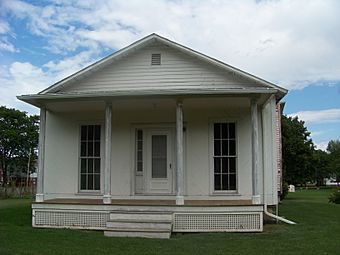John W. Jones House facts for kids
Quick facts for kids |
|
|
John W. Jones House
|
|
 |
|
| Location | Elmira, New York |
|---|---|
| Built | 1868 |
| NRHP reference No. | 03001019 |
| Added to NRHP | October 10, 2003 |
The John W. Jones House is a historic building in Elmira, New York. It is located at 1250 Davis Street, right across from Woodlawn Cemetery. This house was once the home of John W. Jones. Today, it is a museum dedicated to his life and the history of the Underground Railroad.
The house was built in 1868. It was originally a private home for John W. Jones and his family. Over the years, the house changed owners many times. It was even used as a rental property and became very run down. In 1997, the city of Elmira decided it should be torn down. But a person named Lucy Brown and other concerned citizens worked hard to save it. Thanks to them, the house was saved from demolition. Now, it is an important museum.
Who Was John W. Jones?
John W. Jones was an amazing person who came to Elmira in the 1840s. He had escaped slavery in Virginia. He became a very active abolitionist. Abolitionists were people who worked to end slavery. John W. Jones helped many enslaved people find freedom through the Underground Railroad. The Underground Railroad was a secret network of safe houses and routes. It helped enslaved people escape to free states or Canada.
John W. Jones also worked as the sexton of Woodlawn Cemetery. A sexton is a person who takes care of a church or cemetery. During the American Civil War, he had a very important job. He was responsible for burying the Confederate soldiers who died at the Elmira prison camp. This part of the cemetery later became Woodlawn National Cemetery. Parts of the John W. Jones House were even built using materials from the prison camp after it closed. The house was added to the National Register of Historic Places in 2003. This means it is recognized as an important historical site.
The John W. Jones Museum
The John W. Jones House is now home to a museum. This museum teaches visitors about Elmira's special role in the Underground Railroad. Elmira was a key stop between Philadelphia and St. Catharines, Canada. The museum also shows how involved Mr. Jones was in his community. It highlights his relationships with other important people of his time.
You can also learn about the history of African Americans who settled in the Southern Tier of New York. The museum shares stories of local abolitionists. These were the brave people who fought against slavery in the area. The museum helps us remember the important history of freedom and justice.
Gallery






